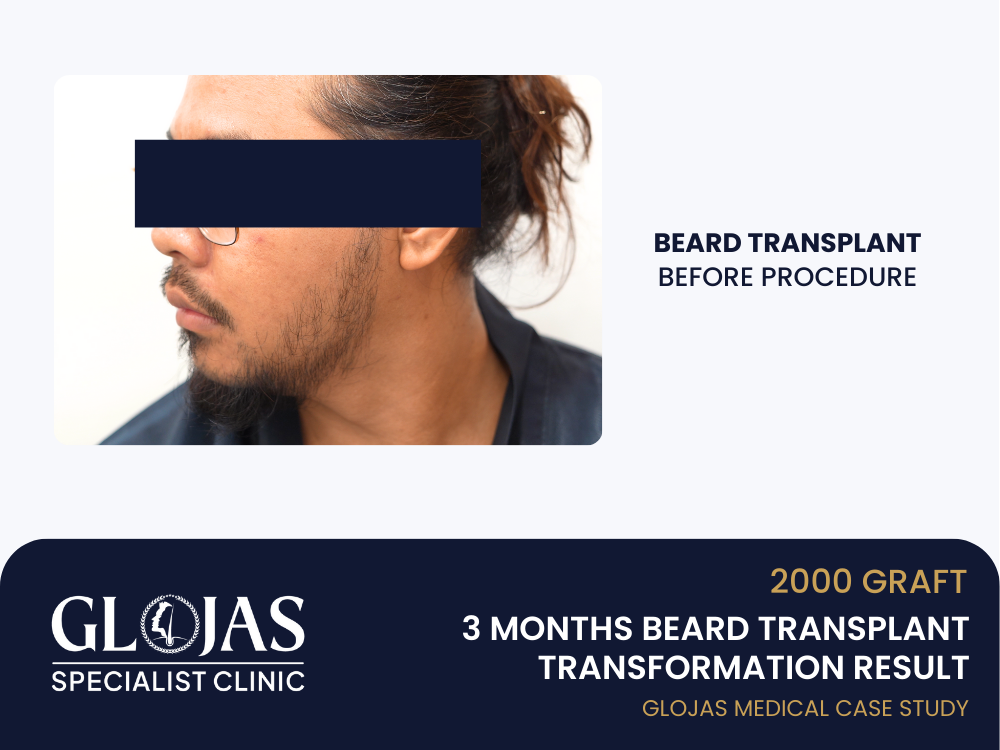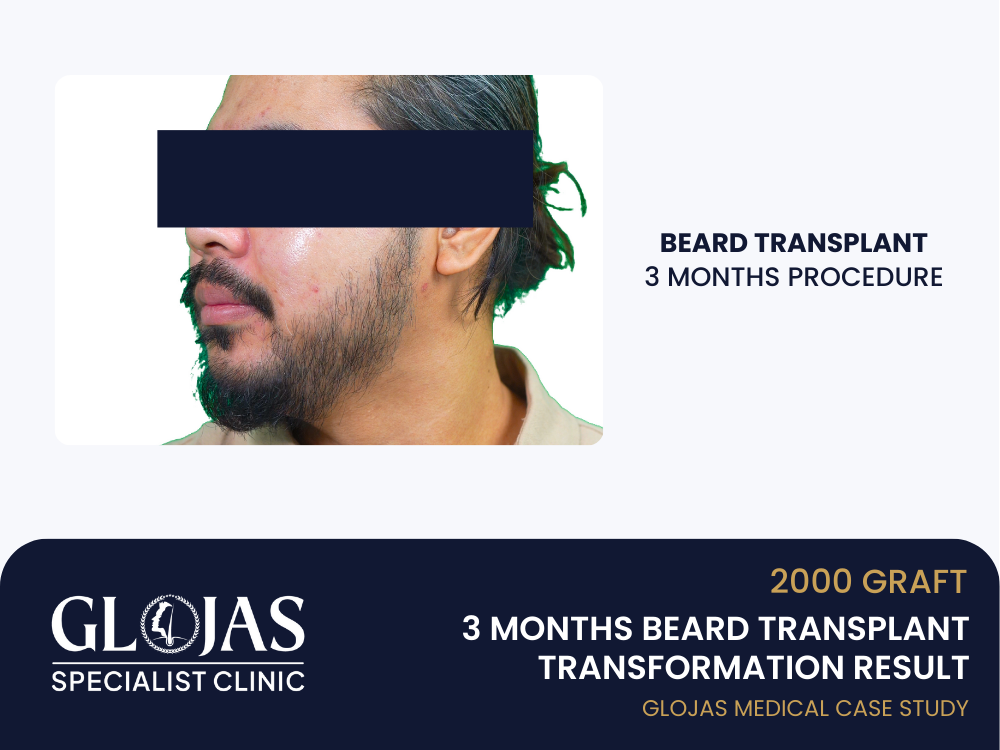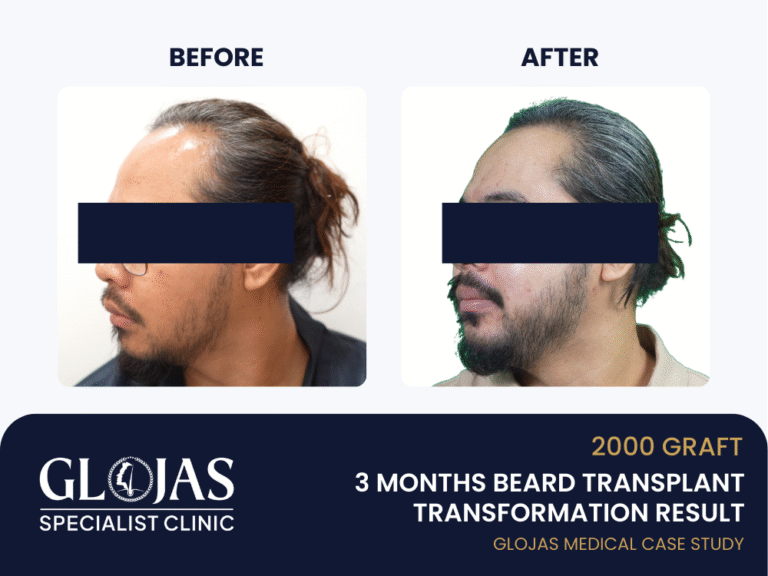For many men, having a thick, well-shaped beard is more than just a trend — it’s a symbol of masculinity, confidence, and personal style. Unfortunately, not all men are genetically blessed with even facial hair growth. Patchy or thin beards are a common issue, and often, grooming products or supplements simply don’t work.
This case study showcases how the SMART™ FUE Beard Transplant technique transformed one patient’s beard in just 3 months using 2,000 hair grafts, providing natural-looking density and definition.
Patient Background
Patient Name: Mr. A (identity kept anonymous for privacy)
Age: 29
Primary Concern: Extremely thin and patchy beard, especially on cheeks and sideburns
Beard Goals: Achieve full, uniform beard coverage with natural density and shape
Hair Donor Area: Occipital scalp (back of the head)
Mr. A had tried several beard oils, minoxidil, and multivitamins over the years — all without significant improvement. His self-confidence was affected, and grooming routines became increasingly frustrating.
The Consultation & Planning Process
During his consultation at a certified SMART™ Hair Restoration clinic, Mr. A underwent a thorough facial hair analysis, donor hair assessment, and digital beard simulation.
Key Findings:
Beard density: <15 follicles/cm² (average male density = 35–40 follicles/cm²)
Donor hair quality: Healthy, thick-caliber scalp hair
Skin type: Fitzpatrick Type III (moderate healing response)
The beard transplant was recommended using the SMART™ FUE method, with an estimated 2,000 grafts to achieve natural coverage from cheek to jawline and under the chin.
Why SMART™ FUE?
SMART™ (Scalp Micro-Advanced Restoration Technique) is a refined version of traditional FUE (Follicular Unit Extraction), offering:
✅ Higher graft survival rates (90–95%)
✅ Less trauma to donor and recipient sites
✅ No linear scarring
✅ Faster healing and minimal downtime
✅ Precise angling for natural hair direction
For beard transplants, angling and hair direction are crucial to achieve realistic results. That’s where SMART™ stands out.
The Procedure: What Happened on the Day?

The full procedure took place over 6 hours in a fully equipped surgical suite.
Steps:
Design & Marking: A custom beard line was drawn based on Mr. A’s facial features
Donor Harvesting: Using a micro punch tool (0.8mm), 2,000 grafts were extracted from the scalp
Graft Preparation: Grafts sorted by size (1–3 hairs per follicle)
Implantation: Precision placement of each graft into pre-made recipient sites, following natural hair direction and density plan
Pain level: Minimal to none, due to local anesthesia
Downtime: 2–3 days of mild swelling and redness
Post-Op Care & Recovery

Mr. A was given a complete post-operative kit including:
Gentle cleanser & saline spray
Antibiotic ointment
Oral anti-inflammatory and antibiotics
Beard care guidelines (no shaving, scratching, or touching for 10–14 days)
Shock loss (temporary shedding) occurred at week 3, which is normal in hair transplants.
3-Month Results: What Changed?

At the 3-month mark, Mr. A returned for evaluation. His results were impressive:
| Area | Before | After (3 months) |
|---|---|---|
| Cheeks | Patchy, thin | 60–70% visible growth |
| Sideburns | Sparse, uneven | Connected & defined |
| Jawline | No density | Filled and shaped |
| Confidence Level | Low | Very satisfied with progress |
Photos showed noticeable filling of the beard zone, particularly the cheeks and jawline. While full results typically take 9–12 months, early growth was already reshaping his face.
Benefits Noticed by the Patient
✔️ Improved facial symmetry and masculinity
✔️ Reduced grooming stress — no need for beard filler or pencil
✔️ Higher confidence in professional and social settings
✔️ Natural look — no one could tell it was a transplant
What to Expect Next
Mr. A was advised that:
80–90% of the transplanted hair will regrow by month 6–9
The beard can be trimmed and styled after 4–6 weeks
Final result visible at 12 months post-transplant
If needed, he plans to return for a touch-up session to enhance volume further.
5 Frequently Asked Questions (FAQ)
1. How long does a full beard transplant take to show results?
Results start to appear between 3–4 months, but final results typically take 9–12 months.
2. Will the transplanted beard hair grow like normal facial hair?
Yes. Once healed, the new beard hair can be shaved, trimmed, and styled like natural facial hair.
3. Is SMART™ FUE better than regular FUE?
Yes. SMART™ FUE offers better graft survival rates, precise placement, and faster healing, which are especially important in areas like the face.
4. Are the results permanent?
Absolutely. Transplanted hair is taken from the scalp, which is genetically permanent, making results last a lifetime.
5. Can I go back to work the next day?
Most patients take 2–3 days off due to mild redness or swelling. You can resume non-strenuous work quickly.
Conclusion
This case study demonstrates how a SMART™ FUE beard transplant using 2,000 grafts can offer a visible transformation in just 3 months, especially for men struggling with thin or patchy beards.
If you’re considering a beard transplant, the SMART™ method provides natural results, minimal downtime, and high satisfaction, especially when performed by experienced specialists.
Want to know if you’re a suitable candidate? Book a consultation today and take the first step toward the beard you’ve always wanted.
